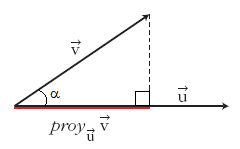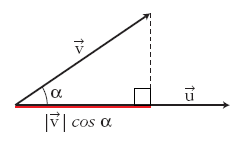Vectores: Producto escalar (1ºBach)
De Wikipedia
(Diferencia entre revisiones)
| Revisión de 13:02 15 mar 2009 Coordinador (Discusión | contribuciones) (→Perpendicularidad y producto escalar) ← Ir a diferencia anterior |
Revisión de 13:05 15 mar 2009 Coordinador (Discusión | contribuciones) Ir a siguiente diferencia → |
||
| Línea 2: | Línea 2: | ||
| |ir= | |ir= | ||
| |ampliar= | |ampliar= | ||
| - | |repasar= | + | |repasar=[http://maralboran.org/web_ma/descartes/Bach_CNST_1/Vectores_en_el_plano/Vectores6.htm#11producto Act. Interactivas] |
| |enlaces= | |enlaces= | ||
| }} | }} | ||
Revisión de 13:05 15 mar 2009
Menú:
| Enlaces internos | Para repasar o ampliar | Enlaces externos |
| Indice Descartes Manual Casio | Act. Interactivas | WIRIS Geogebra Calculadoras |
Tabla de contenidos |
Producto escalar de vectores
Se llama producto escalar de dos vectores  y
y  , al número real que se obtiene multiplicando los módulos de ambos vectores por el coseno del ángulo que forman:
, al número real que se obtiene multiplicando los módulos de ambos vectores por el coseno del ángulo que forman:

Propiedades del producto escalar
Perpendicularidad y producto escalar
Nulidad y perpendicularidad
- Nulidad: Si cualquiera de los dos vectores,
 o
o  , es
, es  , entonces
, entonces  .
.
- Perpendicularidad Dados dos vectores no nulos,
 y
y  , se cumple que
, se cumple que

Demostración:
- Nulidad: Esta propiedad es inmediata.
- Perpendicularidad Si ambos vectores no son nulos, entonces, para que le productro escalar sea cero, debe ser cero el coseno del ángulo que forman esto ocurre sólo si el ángulo es de 90º.
Signo del producto escalar
Signo del producto escalar
El signo del producto escalar queda determinado por el ángulo que forman los vectores:
 si
si  es agudo.
es agudo.
 si
si  es obtuso.
es obtuso.
Demostración:
Esta propiedad es inmediata, ya que el coseno de un ángulo es positivo, si éste es agudo, y negativo, si es obtuso.
Operaciones con el producto escalar
Operaciones
- Propiedad conmutativa:
 .
.
- Propiedad asociativa:
 .
.
- Propiedad distributiva:
 .
.
Demostración:
Proyección de vectores y producto escalar
Proposición: Proyección de vectores
 Demostración: |








